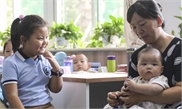COMMENTS / COLUMNISTS
Third-child policy, robotics, to ensure unceasing economic growth

Illustration: Xia Qing/GT
China's central government has moved to revise the country's population policy by allowing couples to give birth to three children, and at the same time, pledging to invest more resources to improve parenting and reduce the cost of education. The new policy, meted out just prior to June 1, the International Children's Day, is to stabilize the country's labor force and to buttress continuous rapid economic growth.The new policy is taken after a massive census conducted in late 2020, in which up to 7.1 million people went door-to-door to collect information from all households in China, showed that 12 million babies were born last year, marking a steep drop from the 18 million born in 2016.
It is this significant decline that has driven the country's top decision-makers to take measures to encourage new child-births, and prevent the country from slipping too quickly to become an irrevocably graying society.
Now, a number of people in the West seem rejoiced seeing the demographic change in this country, asserting the declining birth rate will cloud China's long-term economic prospects and may eventually impair the country's global competitiveness. A rapidly aging population, some claim, means that China's economy will never overtake that of the US, or do so only fleetingly.
But a demographic crisis is highly unlikely to materialize in China.
Those Westerners are oblivious to the Chinese government's ability to take prompt and effective remedies in the face of any challenges - as has been displayed by the quick and firm response China took to stifle the spread of the coronavirus and save lives in the country in early 2020. The three-child family policy is thus pronounced to address the falling birth rate and ensure continuity of growth.
All the more, China has made significant strides in automating its industries, broadly using robotics and other technologies to substitute manpower at the factories, farms and in catering positions.
Even if the country's total population drops by several millions from the current 1.41 billion in the next few years to come, China's modernization will not be upended. The country's GDP is poised to grow at an annual rate of 5-6 percent in the coming decade. Chinese workers' salaries level has kept on rising, and the majority of the population are getting fairly better-off now.
So, a right mix of new policies - prolonged official retiring age, financial stipends for new babies, subsidized preschool, middle school and college education, longer maternity leave - are able to maintain yearly new-born babies at above 10 million or more, providing sufficient labor force needed by the country's further development.
Over the past 40 years, China's demographic trends have been largely shaped by the "one-child" family planning policy, which was introduced in 1979 to slow down an explosive population growth. In 2016, the central government ended that policy and allowed couples to have two children. Unfortunately this change did not reverse the falling birth rate despite a two-year increase immediately afterwards.
Some people in China fault the "one-child" policy for causing the precipitation of child births. But scientific demographic analysis reveals that if that policy was not implemented, the country would have been overly populated with at least 1.7 billion people by now, with a big proportion of them impoverished, if not starved. That couples giving birth to 6-7 children on average from 1950s to 1970s was just unsustainable.
Taking the history as a lesson, China's latest policy to allow couples to have three children is not aimed at persuading them to have as many babies as possible.
The couples living in expensive cities such as Beijing, Shanghai and Shenzhen may wish to delay child-birth, those in the vast and outlying countryside will likely still follow Chinese tradition and want large families, which will lead to a relapse into rural poverty and deterioration of ecology.
Nowadays, preferences have shifted toward smaller families the world over. It has proved to be increasingly difficult to persuade urban educated women to have three or more children. Because these women are more prone to pursue their own career achievements while enjoying growing personal freedom. As shown in neighboring South Korea and Japan, years of government efforts there to make women give birth to more children and reverse their sliding birth rates have largely failed.
Accompanying the three-child population policy, China's central government said that a set of "supportive measures" will be mapped out and enforced soon. There measures will be conducive to improving the country's population structure, fulfilling the strategy of actively coping with an aging population and maintaining the advantage and endowment of human resources.
Chinese demographers suggest the government work out a comprehensive set of favorable policies, including universal provision of child care, tax incentives for child-bearing couples, education and housing subsidies, to inspire couples to have three children. Only through the birth- and parenting-friendly package of policies, would the overall sluggish pattern of fertility in China be addressed.
The author is an editor with the Global Times. bizopinion@globaltimes.com.cn


